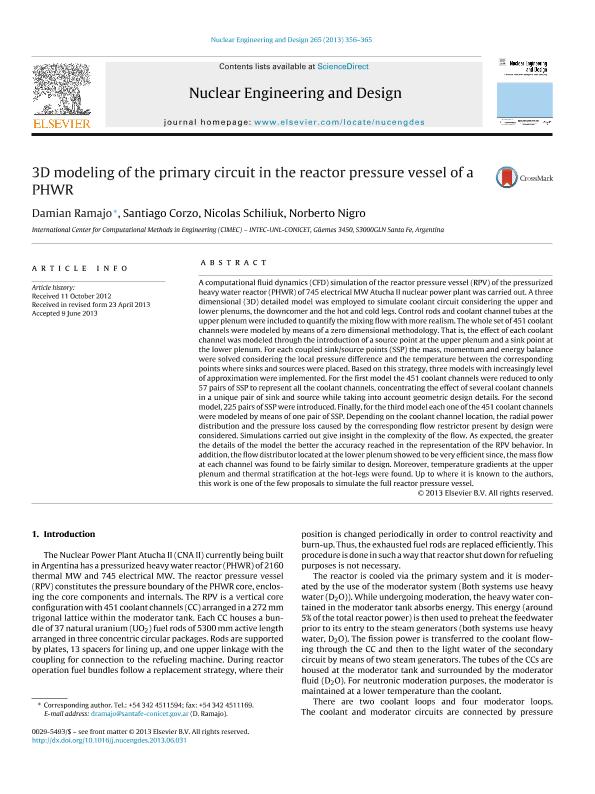Mostrar el registro sencillo del ítem
dc.contributor.author
Ramajo, Damian Enrique

dc.contributor.author
Corzo, Santiago Francisco

dc.contributor.author
Schiliuk, Nicolás

dc.contributor.author
Nigro, Norberto Marcelo

dc.date.available
2016-12-02T18:32:32Z
dc.date.issued
2013-12
dc.identifier.citation
Ramajo, Damian Enrique; Corzo, Santiago Francisco; Schiliuk, Nicolás; Nigro, Norberto Marcelo; 3D modeling of the primary circuit in the reactor pressure vessel of a PHWR; Elsevier Science Sa; Nuclear Engineering And Design; 265; 12-2013; 356-365
dc.identifier.issn
0029-5493
dc.identifier.uri
http://hdl.handle.net/11336/8697
dc.description.abstract
A computational fluid dynamics (CFD) simulation of the reactor pressure vessel (RPV) of the pressurized heavy water reactor (PHWR) of 745 electrical MW Atucha II nuclear power plant was carried out. A three dimensional (3D) detailed model was employed to simulate coolant circuit considering the upper and lower plenums, the downcomer and the hot and cold legs. Control rods and coolant channel tubes at the upper plenum were included to quantify the mixing flow with more realism. The whole set of 451 coolant channels were modeled by means of a zero dimensional methodology. That is, the effect of each coolant channel was modeled through the introduction of a source point at the upper plenum and a sink point at the lower plenum. For each coupled sink/source points (SSP) the mass, momentum and energy balance were solved considering the local pressure difference and the temperature between the corresponding points where sinks and sources were placed. Based on this strategy, three models with increasingly level of approximation were implemented. For the first model the 451 coolant channels were reduced to only 57 pairs of SSP to represent all the coolant channels, concentrating the effect of several coolant channels in a unique pair of sink and source while taking into account geometric design details. For the second model, 225 pairs of SSP were introduced. Finally, for the third model each one of the 451 coolant channels were modeled by means of one pair of SSP. Depending on the coolant channel location, the radial power distribution and the pressure loss caused by the corresponding flow restrictor present by design were considered. Simulations carried out give insight in the complexity of the flow. As expected, the greater the details of the model the better the accuracy reached in the representation of the RPV behavior. In addition,the flow distributor located atthe lower plenum showed to be very efficient since,the mass flow at each channel was found to be fairly similar to design. Moreover, temperature gradients at the upper plenum and thermal stratification at the hot-legs were found. Up to where it is known to the authors, this work is one of the few proposals to simulate the full reactor pressure vessel.
dc.format
application/pdf
dc.language.iso
eng
dc.publisher
Elsevier Science Sa

dc.rights
info:eu-repo/semantics/openAccess
dc.rights.uri
https://creativecommons.org/licenses/by-nc-nd/2.5/ar/
dc.subject
Nuclear Reactor
dc.subject
Phwr
dc.subject
Thermo-Hydraulics
dc.subject
Cfd
dc.subject.classification
Ingeniería Nuclear

dc.subject.classification
Ingeniería Mecánica

dc.subject.classification
INGENIERÍAS Y TECNOLOGÍAS

dc.title
3D modeling of the primary circuit in the reactor pressure vessel of a PHWR
dc.type
info:eu-repo/semantics/article
dc.type
info:ar-repo/semantics/artículo
dc.type
info:eu-repo/semantics/publishedVersion
dc.date.updated
2016-12-02T15:59:02Z
dc.journal.volume
265
dc.journal.pagination
356-365
dc.journal.pais
Países Bajos

dc.journal.ciudad
Ámsterdam
dc.description.fil
Fil: Ramajo, Damian Enrique. Consejo Nacional de Investigaciones Científicas y Técnicas. Centro Científico Tecnológico. Centro de Investigación de Métodos Computacionales; Argentina
dc.description.fil
Fil: Corzo, Santiago Francisco. Consejo Nacional de Investigaciones Científicas y Técnicas. Centro Científico Tecnológico. Centro de Investigación de Métodos Computacionales; Argentina
dc.description.fil
Fil: Schiliuk, Nicolás. Consejo Nacional de Investigaciones Científicas y Técnicas. Centro Científico Tecnológico. Centro de Investigación de Métodos Computacionales; Argentina
dc.description.fil
Fil: Nigro, Norberto Marcelo. Consejo Nacional de Investigaciones Científicas y Técnicas. Centro Científico Tecnológico. Centro de Investigación de Métodos Computacionales; Argentina
dc.journal.title
Nuclear Engineering And Design

dc.relation.alternativeid
info:eu-repo/semantics/altIdentifier/url/http://dx.doi.org/10.1016/j.nucengdes.2013.06.031
dc.relation.alternativeid
info:eu-repo/semantics/altIdentifier/url/http://www.sciencedirect.com/science/article/pii/S0029549313004986
Archivos asociados
